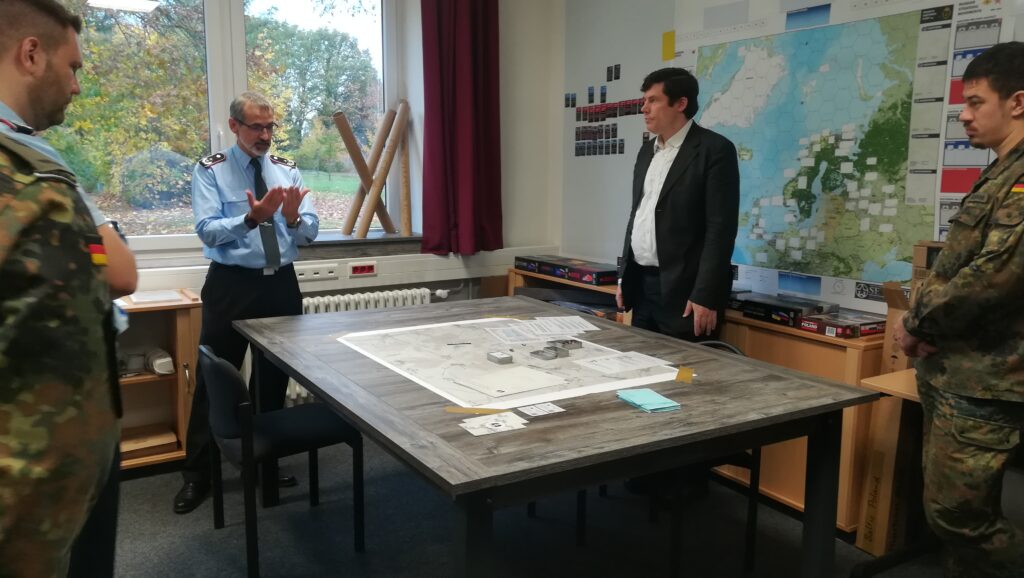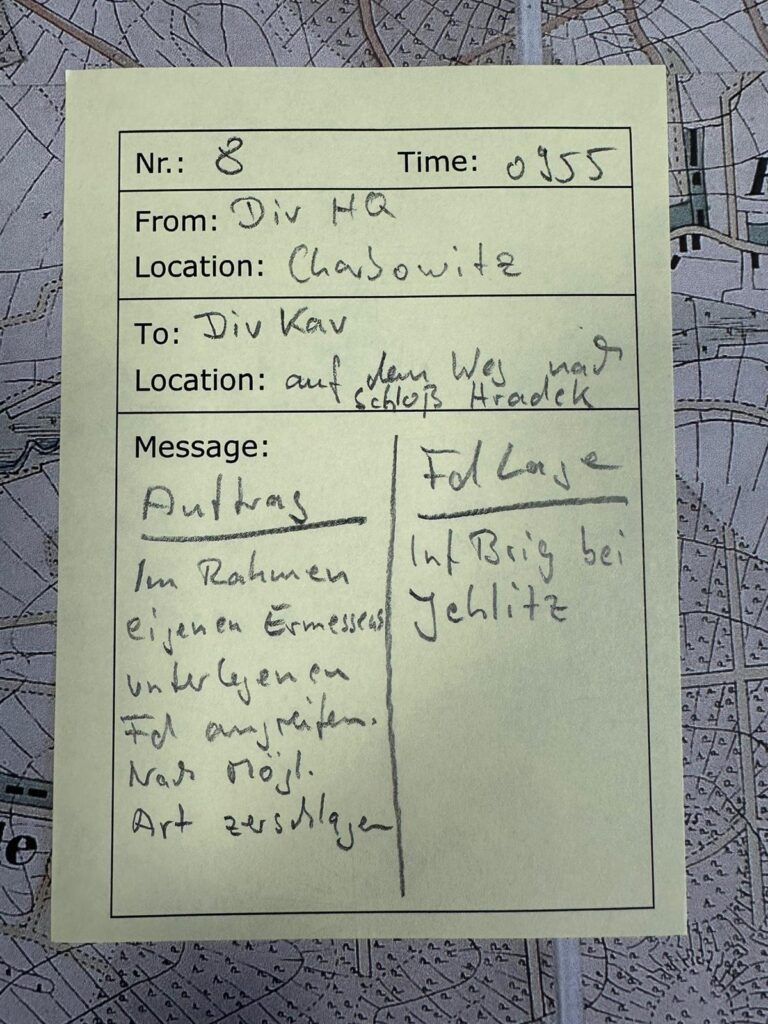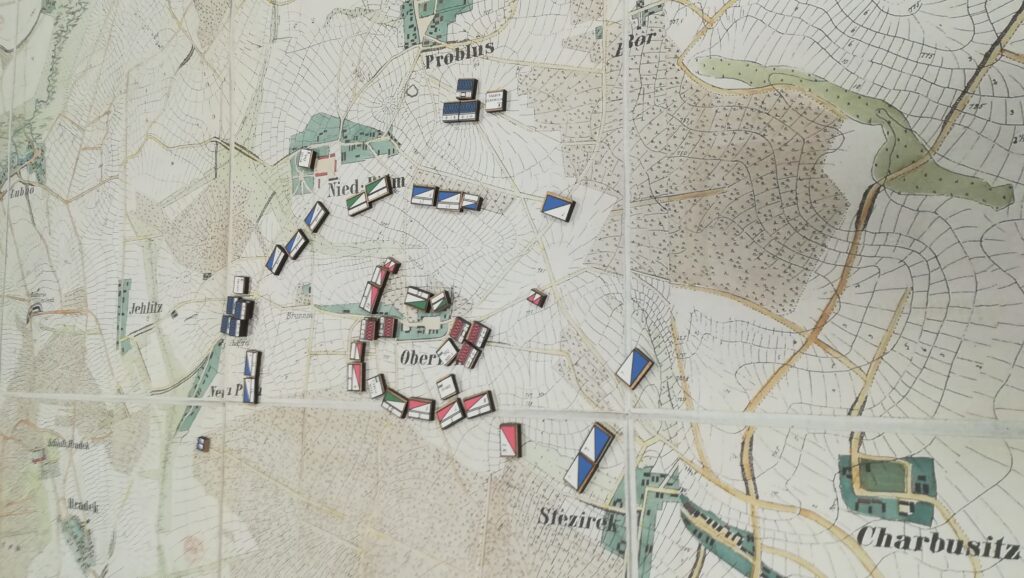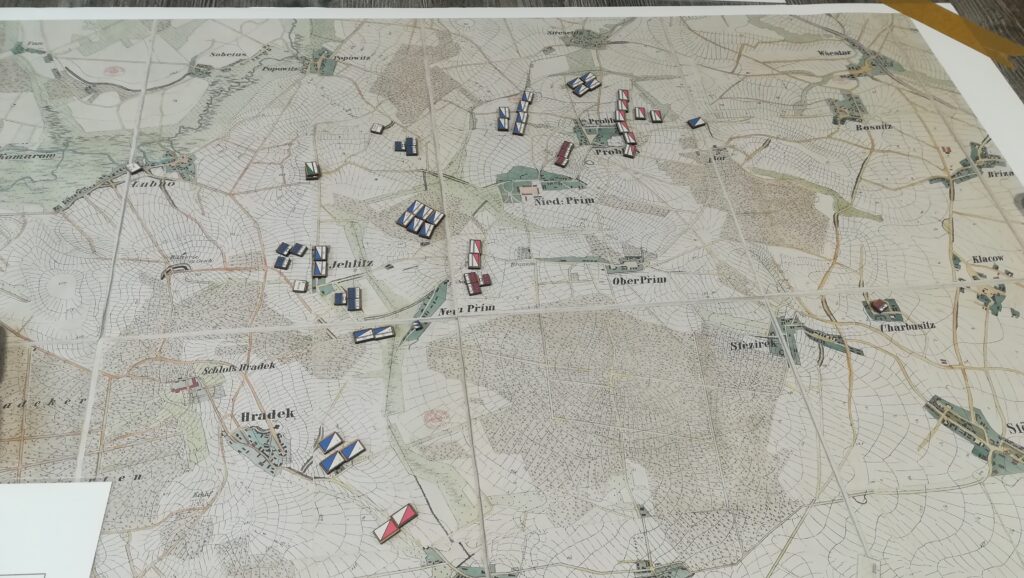Having shown some interest in Neustart, a civic blackout simulation, I was invited by Lieutenant Colonel (GS) Thorsten Kodalle, head of the Innovation Laboratory at the Bundeswehr Command and Staff College, to attend a game demonstration on November 7. Learning that a game of Kriegsspiel would be hosted the day after, I happily took the opportunity to spend two days in Hamburg and meet with wargaming practitioners.
When all lights go out
Neustart is a cooperative crisis simulation boardgame, which is available in a basic version and an upgraded professional version. In the game, players take the role of communal services, when a blackout occurs due to a breakdown of the European energy network.

Players then have to coordinate and try to provide sufficient supplies to the citizens, take care of fires, injured persons, violence and other events, while the responding teams get exhausted. The game teaches not only coordination and decision-making skills under time pressure, but also the importance of critical infrastructure and preparedness to improve civic resilience. Thanks for running the game for us, Thorsten!
You can find out more at https://www.neustart-das-spiel.eu/ (English event cards and rules are available, send an e-mail to the publisher, if you are ordering from outside the EU).

The Prussian Kriegsspiel
What else to do at the German Command and Staff College, if not playing Kriegsspiel, right? Right. Well, interestingly enough, Kriegsspiel had only been “rediscovered” about five years ago, and thus many staff officers, including all of the players besides me, hadn’t played it before.
The game was hosted by professor Jorit Wintjes of the Conflict Simulation Group at the University of Würzburg, who has thoroughly studied the history of Kriegsspiel and published an annotated edition of Tschischwitz’s 1873 rules. Professor Wintjes was assisted by ConSim Group co-founder Steffen Pielström and four young staff officers and army students.
Four pages of basic information, two pages of briefing, one page of order of battle, game pieces, replacements and generic enemy pieces, movement and range measurements, together with a stack of order notes were provided to both teams.
The game saw two divisions of almost similar composition oppose each other. The teams, representing the respective division staff, each shared a map and were able to discuss and divide the workload between their team members. Three senior officers played the Saxon defenders against Fabian’s and my Prussian attackers.


The scenario
The scenario was based on the battle of Königgrätz, which was part of the Austro-Prussian War in 1866. The city of Königgrätz is to the southeast from the map segment.
The Prussian forces comprised the 14th Division with headquarters at Lubno, commanding the brigades Hiller and Schwarzkopp, each fielding 5 battalions (10 half-battalion blocks), an attached battery and a squadron of dragoons each, with a reserve of another battery, 2 squadrons of the same dragoon regiment and 1 battalion of Jäger (specialized light infantry). The initial deployment can be seen on the right.
The Saxon forces were comprised of an infantry division, formed by two infantry brigades. Those were supported by only two artillery batteries and two squadrons of cavalry.
Their general plan was to send the cavalry to keep an eye on the southern passage and the woods on their brigades’ left, and potentially get into the Prussians’ rear. Meanwhile the infantry brigades were supposed to establish positions in the hills of Neu-Prim and between Nieder-Prim and Problus, keeping several battalions in reserve at Ober-Prim, which were to be committed, once the Prussians would be engaged with the main battle line in order to outflank them.


How the battle played out
The Prussian objective was to destroy the Saxon defenders, who formed the Austrian left flank, in detail. They were assumed between Stösser and Briza in the east.
Initially, our forward scouts hadn’t reported any contact, thus we gave the order for a general advance. Having contemplated a push through Techlowitz in the south, we discarded that idea in order to prevent getting beaten in detail with one brigade out of position. Instead, brigade Hiller was supposed to advance against Ober-Prim, while brigade Schwarzkopp was to take Problus.
Quickly, however, we received message that some enemy forces were holding the hills west of Ober-Prim, opposing Hiller, and a brigade was holding Problus, opposing Schwarzkopp. The latter was thus ordered to form battle line and send the smaller regiment to threaten the enemy’s flank from the north, while, for some reason, one of Hiller’s regiments evaded into a patch of woods, which made us believe that there was more to the enemy position than what the reports told us.
From the south, we received indications of an enemy regiment of cavalry advancing against Hiller’s flank, and thus ordered the reserve cavalry and one of Hiller’s battalions to screen it. The reserve artillery was sent to support Schwarzkopp in the north, and the Jäger were ordered to take Nieder-Prim in order to potentially threaten the enemy positions north and south of it.




All along the line, a stalemate developed, until Schwarzkopp was attacked by the opposing Saxon brigade, which, due to a misunderstanding, had deployed much farther forward than intended. Although Schwarzkopp and the opposing brigade fought with approximately equal numbers, the dice gods were with the Prussians that day and they somehow managed to win every single engagement from there on, until running into invincible Saxon Jäger.
With the Saxons giving ground, Schwarzkopp was ordered to launch the assault, and drove the enemy back beyond Problus and Nieder-Prim. The reports sent back to the Prussian headquarters in Lubno repeatedly stated that the “enemy has been completely destroyed”, thus we kept ordering Schwarzkopp forward relentlessly, in order to prevent the Saxons from rallying. In reality, though, brigade Schwarzkopp was also taking heavy casualties, while there was no reserve available to refresh the attack and exploit its success, while brigade Hiller was but sitting and waiting for the right moment. Meanwhile the Prussian cavalry drove the enemy horse, which turned out to be mere two squadrons, back to Stezirek in the enemy’s rear.
Both teams decided to relocate their headquarters to positions very close to the actual fighting, when it appeared crucial to assess the situation in more detail and be able to give orders much more quickly. Eventually, Hiller was making ground and the Saxons were driven back to Ober-Prim. It must be said that, even though the Saxon forces were encircled in the end, valiantly repelling several attacks with their Jäger battalion, the Prussians did pay a high toll to achieve victory in this game.


The debriefing discussion was very enlightening for all participants and did not only focus on the game but also the general benefits of Kriegsspiel as an educational tool (see my thoughts on why Kriegsspiel is still relevant for modern wargaming). Thanks a lot to Jorit, Steffen and the assistants for running the game for us!
It was a pleasure to participate in the games, meet practitioners I had only been in touch with online so far, and connect with others who care deeply about the utilization of educational wargaming. We will surely stay in touch and I am looking forward to future cooperations.
Thank you so much, Thorsten, for your hospitality. I hope to be back in Hamburg, soon.

Join our Discord server and become part of a growing community of over 1,700 members from all around the globe.
Get in touch either on Discord or via e-mail, leave us some feedback or suggestions or ask us anything about Kriegsspiel.
The IKS is commited to ensure inclusiveness and diversity within the community and stands against discrimination and harassment.
We endorse the Derby House Principles.






